Shuttle XPC slim DH370 mini-PC Review: A Compact Digital Signage Powerhouse
by Ganesh T S on May 6, 2019 8:00 AM ESTBAPCo SYSmark 2018
The Shuttle XPC slim DH370 was evaluated using our Fall 2018 test suite for small-form factor PCs. In the first section, we will be looking at SYSmark 2018.
BAPCo's SYSmark 2018 is an application-based benchmark that uses real-world applications to replay usage patterns of business users in the areas of productivity, creativity, and responsiveness. The 'Productivity Scenario' covers office-centric activities including word processing, spreadsheet usage, financial analysis, software development, application installation, file compression, and e-mail management. The 'Creativity Scenario' represents media-centric activities such as digital photo processing, AI and ML for face recognition in photos and videos for the purpose of content creation, etc. The 'Responsiveness Scenario' evaluates the ability of the system to react in a quick manner to user inputs in areas such as application and file launches, web browsing, and multi-tasking.
Scores are meant to be compared against a reference desktop (the SYSmark 2018 calibration system, a Dell Optiplex 5050 tower with a Core i3-7100 and 4GB of DDR4-2133 memory to go with a 128GB M.2 SATA III SSD). The calibration system scores 1000 in each of the scenarios. A score of, say, 2000, would imply that the system under test is twice as fast as the reference system.
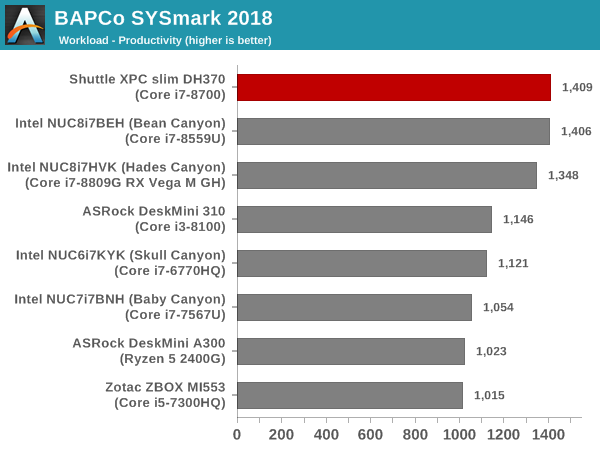
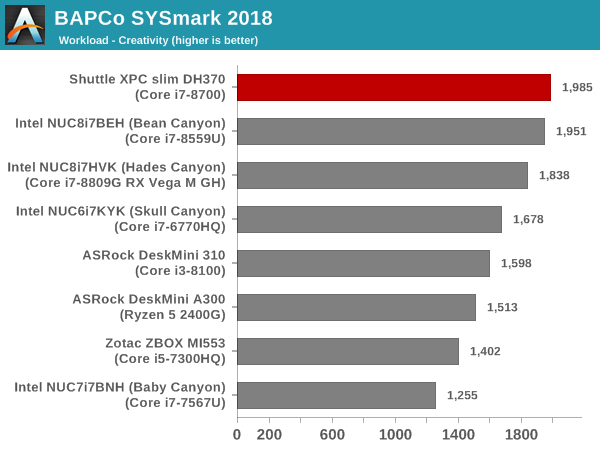
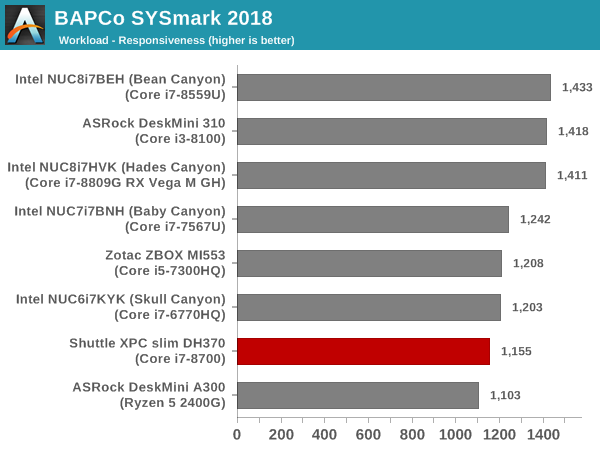
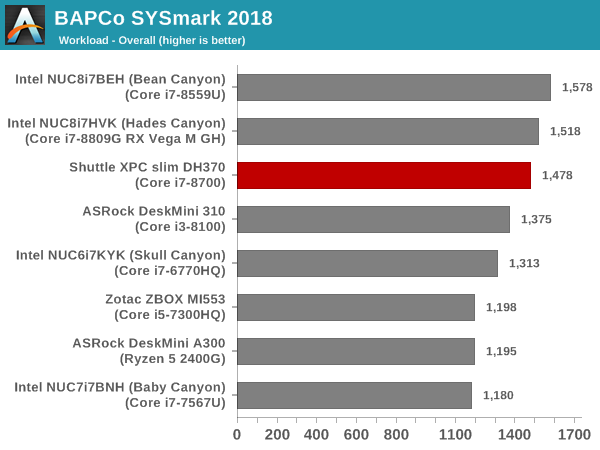
SYSmark 2018 also adds energy measurement to the mix. A high score in the SYSmark benchmarks might be nice to have, but, potential customers also need to determine the balance between power consumption and the efficiency of the system. For example, in the average office scenario, it might not be worth purchasing a noisy and power-hungry PC just because it ends up with a 2000 score in the SYSmark 2014 SE benchmarks. In order to provide a balanced perspective, SYSmark 2018 also allows vendors and decision makers to track the energy consumption during each workload. In the graphs below, we find the total energy consumed by the PC under test for a single iteration of each SYSmark 2018 workload. For reference, the calibration system consumes 5.36 Wh for productivity, 7.71 Wh for creativity, 5.61 Wh for responsiveness, and 18.68 Wh overall.
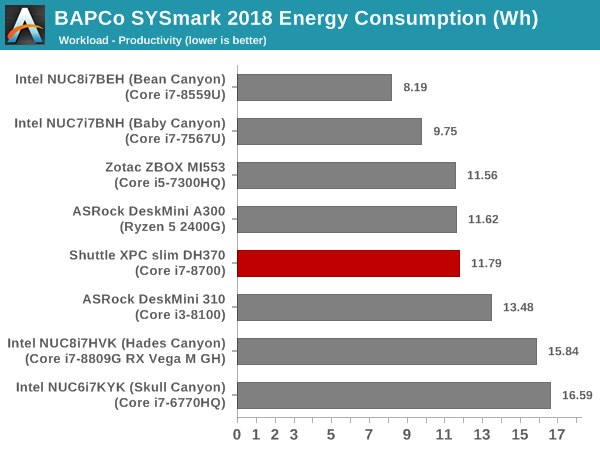
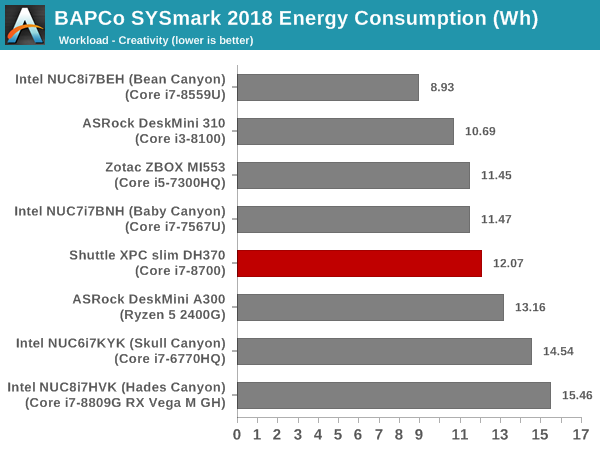
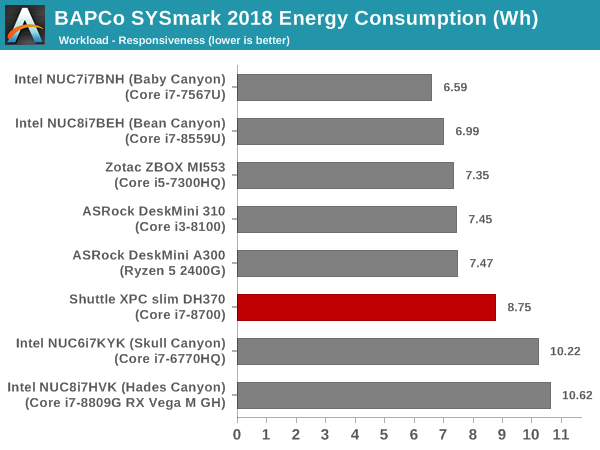

The Core i7-8700 is a powerful hexa-core CPU, and it expectedly leads in a number of scenarios. The system lags in the responsiveness case, likely due to the usage of a PCIe 3.0 x2 SSD (the systems above it in that workload were all benchmarked with a PCIe 3.0 x4 NVMe SSD or an Optane storage drive). Overall, the reviewed Bean Canyon and Hades Canyon NUC configurations provide better performance numbers (albeit, at a much higher cost). On the energy consumption side, the system is somewhat on the back foot, thanks to the usage of a 65W TDP CPU as well as a powerful PCH (compared to the other reviewed systems). The usage of a PCIe 3.0 x2 SSD somewhat offsets this. However, the XPC slim DH370 configuration ends up being better than only the Skull Canyon and Hades Canyon NUCs in that metric.










37 Comments
View All Comments
NaterGator - Monday, May 6, 2019 - link
Now this looks like one heck of a routerbox. If only it had 10GBase-T...fusebokme - Monday, May 6, 2019 - link
I have this box (the XH version) running pfsense on a Pentium Gold G5600. Multiple openvpn connections don't stress it at all. Got G5600 due to high single thread performance (pppoe and openvpn are single threaded). Excellent box. Very stable. Intel NICs. As you say: 10gbit would be icing on the cake but not too many places you can get 10gbit internet yet.JHBoricua - Monday, May 6, 2019 - link
Why? Way too expensive for that purpose, specially when you're limited to two interfaces. A HP T620 Plus with 8GB RAM and 16GB of storage plus a quad port intel i340 card can be built for half of what this costs as a barebones kit.0ldman79 - Tuesday, May 7, 2019 - link
If you're doing traffic shaping, sure.If you're just moving data it's massively overkill.
bill.rookard - Tuesday, May 7, 2019 - link
I have a SuperMicro itx board with an Atom D525 and dual NICs for my pfsense box - super quiet, and solid as a rock. Fraction of the price of this unit.(and no, there are no backdoor chips as far as I can see LOL)
GreenReaper - Tuesday, May 7, 2019 - link
Other than the Intel? Its PVAP (Protected Audio Visual Path) will remain:https://forums.freebsd.org/threads/remote-code-exe...
You might be able to use me_cleaner:
https://github.com/corna/me_cleaner
Of course, you will lose the ability to decode protected formats in hardware:
https://www.techarp.com/bios-guide/pavp-mode/
It may be paranoia to imagine that Intel has deliberately back-doored their decoder, but perhaps less so to imagine that there may be an exploitable bug in the code, especially given recent issues.
Irata - Wednesday, May 15, 2019 - link
It seems that Backdoor chips won't be needed.Hixbot - Monday, May 6, 2019 - link
Another small pc review with no noise measurements...mikato - Monday, May 6, 2019 - link
He has a couple sentences with some subjective noise analysis that was very helpful to me at least. "simply too noisy for use as a HTPC"Hixbot - Tuesday, May 7, 2019 - link
All of Ganesh's small pc reviews need objective noise measurements. It's one of the most important aspects of a HTPC. Temperature measurements are not much help if they can't be compared to noise levels.